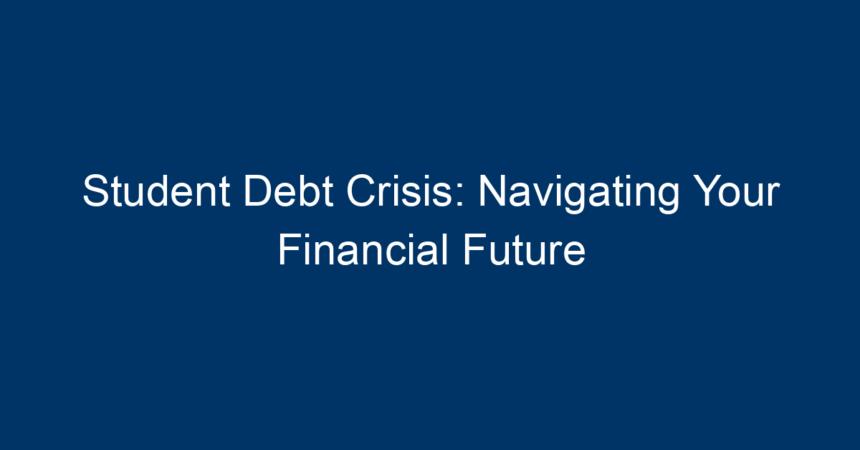The student debt crisis has become a pressing issue affecting millions of individuals and families across the United States. With soaring tuition fees and living costs, many students find themselves burdened with significant debt by the time they graduate. This crisis not only impacts the financial well-being of graduates but also has broader implications for the economy. In this article, we’ll explore the depths of the student debt crisis, its causes, consequences, and practical strategies for navigating your financial future amidst these challenges.
Understanding the Student Debt Crisis
The Current Landscape of Student Debt
As of 2023, student debt in the U.S. exceeds $1.6 trillion, with over 44 million borrowers struggling under the weight of loans. The average student graduates with about $30,000 in debt, a figure that can hinder their financial goals for years to come. This situation is exacerbated by rising interest rates and stagnant wages, creating a perfect storm for new graduates.
Causes of the Student Debt Crisis
Escalating Tuition Costs
One of the primary drivers of the student debt crisis is the skyrocketing cost of tuition. Over the past two decades, public university tuition has increased by roughly 213%. While some argue that this inflation is due in part to state budget cuts, others highlight the institutional priorities that favor administrative spending over student services.
Limited Financial Aid and Scholarships
While many students seek financial aid, insufficient grants and scholarships often leave a sizable gap that must be filled with loans. The reliance on student loans has increased as federal and state governments struggle to keep up with financial aid needs.
Predatory Lending Practices
In recent years, some private lenders have engaged in predatory lending practices, targeting vulnerable students with high-interest loans. This can create a cycle of debt that is challenging to escape, further entrenching individuals in financial hardship.
The Impact of Student Debt
Financial Consequences
The effects of the student debt crisis extend far beyond monthly loan payments. Graduates entering the job market with high levels of debt may delay purchasing homes, starting families, or saving for retirement. This not only affects their personal lives but also slows economic growth as consumer spending remains stifled.
Psychological and Emotional Toll
The psychological burden of student debt can also be overwhelming. Many borrowers experience stress, anxiety, and depression related to their financial situation. This emotional toll can impact career choices, relationships, and general well-being.
Inequities in Education
The student debt crisis disproportionately affects marginalized communities. Black and Hispanic students, for example, often take on more debt than their white counterparts and are less likely to complete their degrees. This inequality not only perpetuates cycles of poverty but also hampers economic mobility for entire communities.
Navigating Student Debt: Strategies for Financial Success
1. Understand Your Loans
Begin your journey by thoroughly understanding the types of student loans you have. Federal loans typically offer more flexible repayment options compared to private loans. Familiarize yourself with the terms, interest rates, and repayment plans associated with your loans to make informed decisions.
2. Explore Repayment Options
Federal student loans offer various repayment plans that can make repayment more manageable. Consider options like Income-Driven Repayment plans, which adjust your monthly payments based on your income. This ensures that you won’t pay more than you can afford, offering financial relief during challenging times.
3. Consider Loan Forgiveness Programs
If you work in a public service sector job, you may qualify for loan forgiveness programs such as Public Service Loan Forgiveness (PSLF). Research eligibility requirements and keep detailed records of your service to take advantage of this potential relief.
4. Create a Budget
Establishing a budget is critical for managing your finances effectively. Track your income and expenses, create a realistic spending plan, and identify areas where you can cut costs. This will help you allocate more resources toward loan payments while still meeting your essential needs.
5. Increase Your Income
Consider side gigs or part-time work to enhance your income. Freelancing, tutoring, or any skill-based work can provide additional funds that can be directed toward your debt. Investing in yourself through additional training or certifications can also boost your earning potential over time.
6. Seek Financial Counseling
If you find yourself overwhelmed, consider seeking help from financial counseling services. Nonprofit organizations offer free or low-cost resources to assist with budgeting, debt management, and overall financial planning. A counselor can provide personalized strategies tailored to your situation.
7. Stay Informed About Policy Changes
Policies regarding student debt are constantly evolving. Stay informed about potential changes in legislation that could affect your repayment options or forgiveness eligibility. Joining advocacy groups or following platforms focused on student debt can keep you updated on the latest developments.
The Role of Financial Literacy
Building a Foundation for the Future
Increasing financial literacy is essential in addressing the student debt crisis. Understanding the financial landscape allows individuals to make informed choices about their education, borrowing, and future economic decisions. Educational institutions, families, and communities must prioritize financial education to empower future generations.
Encouraging Open Conversations
Open discussions about debt, finances, and economic challenges can help reduce stigma and encourage proactive strategies. Schools should incorporate financial literacy courses into their curricula, allowing students to grasp these crucial concepts before they embark on higher education.
Conclusion: Taking Control of Your Financial Future
The student debt crisis is a complex issue that requires a multifaceted approach for resolution. Understanding the causes and impacts of this crisis is the first step in navigating your financial future. By employing strategies such as loan understanding, repayment exploration, budgeting, income enhancement, and seeking guidance, you can take control of your financial situation.
As the landscape of student debt continues to evolve, staying informed and proactive is vital. This crisis may feel insurmountable, but with the right tools and knowledge, you can navigate these turbulent waters. Remember, every small step counts towards a financially secure future. Make your financial well-being a priority and invest in your knowledge; the power to change your circumstances lies within your hands.




